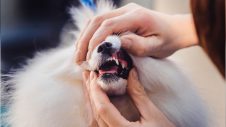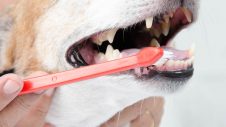It’s estimated that over 80% of dogs and cats over 3 years of age have some form of dental disease. Dental disease causes bad breath (halitosis), inflamed gums and oral pain. It is also a source of infection and can make your pet seriously ill.
Dental disease is preventable in the vast majority of cases. Prevention can be relatively easy to achieve at home. There are many different methods to keep your pet’s teeth ‘pearly white’. and These methods are best started while they are puppies and kittens.
Brushing your pet’s teeth daily is the best option for dental care, which is why humans do it! Brushing is the most thorough method to remove plaque. We will also discuss other measures such as feeding dental diets, playing with chew toys, using rinses, etc.
For dogs and cats with existing dental disease, a dental treatment with a scale and polish under general anaesthetic is almost always necessary. This will allow us to start a tailored prevention program with a clean mouth with the aim of minimising, or slowing down dental disease developing again in the future. It is important to remember, that home care is vital in the prevention of dental disease.
What Are the Risks of Improper Dental Care?
Poor pet dental care can cause a range of conditions and health concerns, much like it would in humans. Beyond the risk of bad breath, improper dental care results in gum or periodontal disease, including bleeding gums and tooth loss. This disease, when left untreated, runs the risk of additional health issues and impacts.
Immune System: The plaque left on your pet’s teeth can cause an inflammatory response within the immune system to kill the bacteria. Through this process, it can affect tissue and lead to infection.
Heart disease: Periodontal disease puts your pet at higher risk of developing endocarditis (heart) conditions. This is likely due to the increased cultured bacteria the plaque causes.
Diabetes: In many cases, diabetes can be challenging to manage well, in the presence of ongoing infection, as is seen with periodontal disease.
Broken Jaw Fractures: The infection and loss of teeth associated with ongoing, severe periodontal disease can weaken your pet’s jaw and increase the risk of jaw fractures.
Brushing Your Pet’s Teeth
Brushing your pet’s teeth daily helps control plaque build-up and hence minimise dental disease. Follow our steps below to accustom your pet to this process.
Select a toothbrush
- Choose a soft toothbrush
- Toddler brushes are great for small dogs and cats
- Dog and cat toothbrushes are available in vet clinics and pet retail stores
- Make sure you label your pet’s toothbrush and keep it separate from the family toothbrushes!
Select a toothpaste
Do not use human toothpaste when brushing your pet’s teeth as your pet may swallow it. Human toothpaste is not designed to be swallowed and has ingredients that can upset your pet’s stomach. Pet toothpaste is often chicken or beef flavoured, which may help your pet accept it. Pet toothpaste is also safe if it is swallowed. Sometimes our pets will like the toothpaste too much! In this case we may suggest dipping the toothbrush in an oral rinse instead.
Introduce Your Pet to Teeth Brushing
Cats and small dogs may feel more comfortable if they can sit on their owner’s lap while having their teeth brushed.
- Begin slowly. Initial sessions should be brief, just a minute or two and well rewarded with a high-flavoured, yummy treat.
- Get your pet used to the toothbrush by dipping it in tuna juice, chicken or beef stock or just use water.
- Next, try offering the toothbrush with the toothpaste, without brushing. Allow your pet to taste the toothpaste.
- When your pet is comfortable with the brush, try brushing one or two strokes on a few teeth. Slowly increase the brushing as your pet becomes more comfortable.
- Start at the front of the mouth. Pets are often more accepting of this.
- For small dogs, try a gauze swab or stocking material wrapped around your finger
- Avoid trying to hold the pets’ mouth wide open while brushing. This is often met with resistance! Instead place the brush up under the lip and start gently.
4 steps to effective teeth brushing
- Correct angle – Hold brush at a 45-degree angle to the gum line.
- Circular motion – Apply the toothbrush and use a circular motion with gentle pressure on the teeth and gum line.
- At least 30-60 seconds – Brush for at least 30-60 seconds on each side of the mouth, remembering the back teeth. It is very difficult to clean the inside surfaces of your pet’s mouth.
- Reward – Reward your pet for their good behaviour. Try using a very special treat that your pet loves and is only used as a reward after brushing.
Other Alternatives to Brushing
While brushing is the best option for at home dental care, it is sometimes not possible due to the personality of your pet, or the amount of spare time you have each day. Listed below are some other alternatives. These are referred to as ‘passive’ care as you are not actively brushing. To get the best results, you will need to use at least two methods of passive care. Remember passive care is reliant on how your pet chews, so not all teeth may be impacted.
Dental Diets
Many premium dental dry pet foods (for example Hills Oral care, Hills T/D, Royal Canin Dental) and special dental treats (for example, Greenies and Orovet chews) are available for both cats and dogs and are specially designed to keep pets’ teeth clean, while still providing them with a complete and balanced diet. These dental foods work using a combination of mechanical and gentle abrasion on the teeth which together help to slow the dental disease process and help prevent plaque forming. You can identify which of them are suitable by looking for the VOHC seal of approval on the packet. If your pet hasn’t started these specially designed foods at an early age, it is best to start them after their teeth have been professionally scaled and polished.
Reducing the Speed of Eating
Dogs and cats teeth need vital contact time with dry food when chewing – dry food assists in removal of plaque. Pets that eat their food very fast, i.e. “gobble”, do not have adequate contact time and therefore plaque accumulates. It’s ideal to slow the speed of eating using slow feeder bowls or dental toys with food placed inside. Consider spreading the food on the floor or for cats and small dogs, or placing food in small muffin trays as opposed to their normal bowls.
Kibble Size
Ensure you have the correct kibble size for the size of your pet’s mouth.
Rinses and Gels
An array of rinses and gels are available to assist in the reduction of plaque. Depending on the product you choose, they can be directly applied to your pets’ teeth and gum area, added to water or sprinkled on food.
Dental Toys
There are some toys available which are great at encouraging your dog to chew. Some of these toys include the Kong and Gumabone. Toys are a useful addition to a dental hygiene program, however they should not be relied on solely.
Bones
Care must be exercised when feeding raw bones as they are not without potential risks. These include fracturing of teeth, becoming caught in the mouth, throat, food pipe, stomach or intestines. If you decide to feed your dog a bone and are aware of the potential risks, please read the below suggestions.
- Do not feed cooked bones as these tend to splinter and cause internal damage.
- Avoid bones with a lot of meat on them – some dogs become frustrated and cannot pull the meat off and therefore swallow the bone whole.
- Always give bones under supervision and remove old bones from the yard. Avoid feeding bones to dogs that are “gobblers”.
- The bone should always be bigger than the dog’s head so it cannot be swallowed.
- Exercise caution with raw poultry bones as they have been associated with neurological disease.
- Avoid cut marrow bones, as the marrow content is very high in fat. This is often associated with pancreatitis, vomiting and diarrhoea.
- Remove the bone before the bone itself is chewed up. Eating the bone itself comes with a significant risk of tooth fracture.
Veterinary Dental Treatments
In the majority of pets’ lives, there comes a time when their teeth may require veterinary treatment over and above their regular examinations. This treatment involves a general anaesthetic and a full dental examination, including charting and scaling, both ultrasonically and by hand, and then finishing with a polish. This is a very similar procedure human dentists use.
Often your veterinarian will take dental x-rays to more completely examine the tooth. After all, more than half of your pets’ tooth is under the gumline!
Dental Home Care for Pets FAQs
Different Diseases and Conditions
Just like humans, our pets can experience a range of different dental diseases. Whilst most common is periodontal disease, other conditions include:
Gingivitis is a disease that affects the gum at the base of your pet’s teeth. Common symptoms include irritation, redness and swelling.
Tooth Resorption involves the tooth resorbing/being eaten away. This often starts under or at the gumline. It is most common in cats and can causes dental pain, muscular spasms, bleeding and difficulty eating.
How frequently teeth should be brushed
Ideally, you should be brushing your pet’s teeth twice a day, just like humans do. However, we know this can be challenging. Plaque changes into hard tartar after about 48 hours. For this reason, some people feel that brushing every other day is sufficient – but remembering to brush every other day is hard habit to form! Once daily is a much easier habit to form. Your vet can provide advice on brushing and getting your pet more comfortable with the sensation.
What Is the Best Dental Care for your pet?
Regular brushing is a great way to remove plaque build-up, keep your pet’s teeth healthy and eliminate bad breath. Read our guide to dog teeth brushing for more advice.
Regular check-ups help your vet observe your pet’s teeth for any changes or conditions and help keep them at optimal health.
Dental treats and foods are a convenient way to introduce dental care into your pet’s daily life.
How Much Is Dental Care for Pets?
The cost of dental care for dogs and cats will vary depending on their condition. Book an appointment at your local Greencross Vet for a fee estimate on their dental care services.
Brushing and dental foods are a great investment in your pet’s long term dental health.
How to Keep Your Dog’s/Cat’s Teeth Clean Without Brushing
If your cat or dog just won’t let you brush their teeth, your Greencross Vet can help find the right dental care solution for your pet. Whilst brushing is best, dental foods, and treats and annual professional cleaning are a convenient way to provide dental care to your pet throughout their regular routines.

 Greencross Vets
Greencross Vets 










